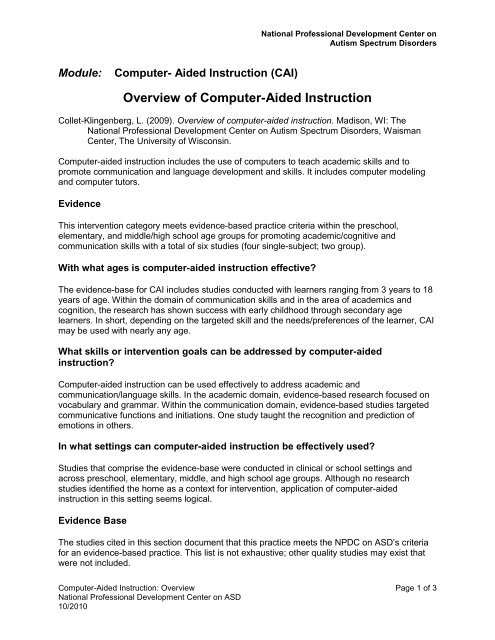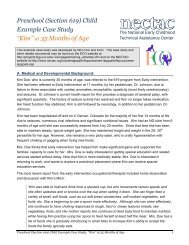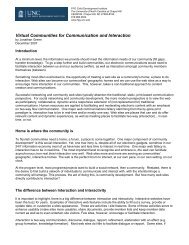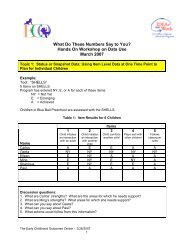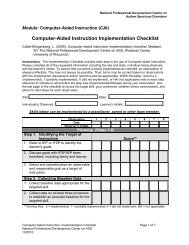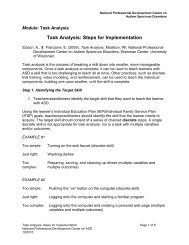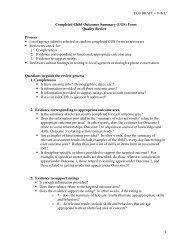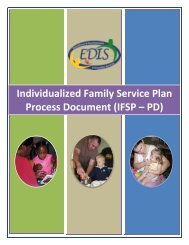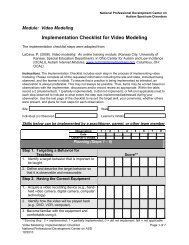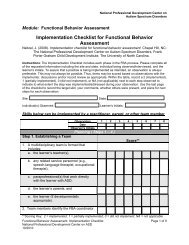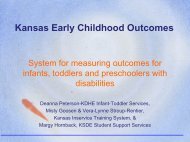Overview of Computer-Aided Instruction - National Professional ...
Overview of Computer-Aided Instruction - National Professional ...
Overview of Computer-Aided Instruction - National Professional ...
You also want an ePaper? Increase the reach of your titles
YUMPU automatically turns print PDFs into web optimized ePapers that Google loves.
<strong>National</strong> Pr<strong>of</strong>essional Development Center on<br />
Autism Spectrum Disorders<br />
Module:<br />
<strong>Computer</strong>- <strong>Aided</strong> <strong>Instruction</strong> (CAI)<br />
<strong>Overview</strong> <strong>of</strong> <strong>Computer</strong>-<strong>Aided</strong> <strong>Instruction</strong><br />
Collet-Klingenberg, L. (2009). <strong>Overview</strong> <strong>of</strong> computer-aided instruction. Madison, WI: The<br />
<strong>National</strong> Pr<strong>of</strong>essional Development Center on Autism Spectrum Disorders, Waisman<br />
Center, The University <strong>of</strong> Wisconsin.<br />
<strong>Computer</strong>-aided instruction includes the use <strong>of</strong> computers to teach academic skills and to<br />
promote communication and language development and skills. It includes computer modeling<br />
and computer tutors.<br />
Evidence<br />
This intervention category meets evidence-based practice criteria within the preschool,<br />
elementary, and middle/high school age groups for promoting academic/cognitive and<br />
communication skills with a total <strong>of</strong> six studies (four single-subject; two group).<br />
With what ages is computer-aided instruction effective<br />
The evidence-base for CAI includes studies conducted with learners ranging from 3 years to 18<br />
years <strong>of</strong> age. Within the domain <strong>of</strong> communication skills and in the area <strong>of</strong> academics and<br />
cognition, the research has shown success with early childhood through secondary age<br />
learners. In short, depending on the targeted skill and the needs/preferences <strong>of</strong> the learner, CAI<br />
may be used with nearly any age.<br />
What skills or intervention goals can be addressed by computer-aided<br />
instruction<br />
<strong>Computer</strong>-aided instruction can be used effectively to address academic and<br />
communication/language skills. In the academic domain, evidence-based research focused on<br />
vocabulary and grammar. Within the communication domain, evidence-based studies targeted<br />
communicative functions and initiations. One study taught the recognition and prediction <strong>of</strong><br />
emotions in others.<br />
In what settings can computer-aided instruction be effectively used<br />
Studies that comprise the evidence-base were conducted in clinical or school settings and<br />
across preschool, elementary, middle, and high school age groups. Although no research<br />
studies identified the home as a context for intervention, application <strong>of</strong> computer-aided<br />
instruction in this setting seems logical.<br />
Evidence Base<br />
The studies cited in this section document that this practice meets the NPDC on ASD’s criteria<br />
for an evidence-based practice. This list is not exhaustive; other quality studies may exist that<br />
were not included.<br />
<strong>Computer</strong>-<strong>Aided</strong> <strong>Instruction</strong>: <strong>Overview</strong> Page 1 <strong>of</strong> 3<br />
<strong>National</strong> Pr<strong>of</strong>essional Development Center on ASD<br />
10/2010
<strong>National</strong> Pr<strong>of</strong>essional Development Center on<br />
Autism Spectrum Disorders<br />
Module:<br />
<strong>Computer</strong>- <strong>Aided</strong> <strong>Instruction</strong> (CAI)<br />
Preschool<br />
Moore, M., & Calvert, S. (2000). Brief report: Vocabulary acquisition for children with autism:<br />
Teacher or computer instruction. Journal <strong>of</strong> Autism and Developmental Disorders, 30(4),<br />
359-362.<br />
Elementary School<br />
Bosseler, A., & Massaro, D. W. (2003). Development and evaluation <strong>of</strong> a computer-animated<br />
tutor for vocabulary and language learning in children with autism. Journal <strong>of</strong> Autism and<br />
Developmental Disorders, 33(6), 653-672.<br />
Hetzroni, O. E., & Shalem, U. (2005). From logos to orthographic symbols: A multilevel fading<br />
computer program for teaching nonverbal children with autism. Focus on Autism and<br />
Other Developmental Disabilities, 20(4), 201-212.<br />
Hetzroni, O. E., & Tannous, J. (2004). Effects <strong>of</strong> a computer-based intervention program on the<br />
communicative functions <strong>of</strong> children with autism. Journal <strong>of</strong> Autism and Developmental<br />
Disorders, 34(2), 95-113.<br />
Massaro, D. W., & Bosseler, A. (2006). Read my lips: The importance <strong>of</strong> the face in a computeranimated<br />
tutor for vocabulary learning by children with autism. Autism, 10(5), 495-510.<br />
Moore, M., & Calvert, S. (2000). Brief report: Vocabulary acquisition for children with autism:<br />
Teacher or computer instruction. Journal <strong>of</strong> Autism and Developmental Disorders, 30(4),<br />
359-362.<br />
Middle/High School<br />
Bosseler, A., & Massaro, D. W. (2003). Development and evaluation <strong>of</strong> a computer-animated<br />
tutor for vocabulary and language learning in children with autism. Journal <strong>of</strong> Autism and<br />
Developmental Disorders, 33(6), 653-672.<br />
Massaro, D. W., & Bosseler, A. (2006). Read my lips: The importance <strong>of</strong> the face in a computeranimated<br />
tutor for vocabulary learning by children with autism. Autism, 10(5), 495-510.<br />
Silver, M., & Oakes, P. (2001). Evaluation <strong>of</strong> a new computer intervention to teach people with<br />
autism or Asperger syndrome to recognize and predict emotions in others. Autism, 5(3),<br />
299-316.<br />
Selected Additional References<br />
Blischak, D. M., & Schlosser, R. W. (2003). Use <strong>of</strong> technology to support independent spelling<br />
by students with autism. Topics in Language Disorders, 23(4), 293-304.<br />
<strong>Computer</strong>-<strong>Aided</strong> <strong>Instruction</strong>: <strong>Overview</strong> Page 2 <strong>of</strong> 3<br />
<strong>National</strong> Pr<strong>of</strong>essional Development Center on ASD<br />
10/2010
<strong>National</strong> Pr<strong>of</strong>essional Development Center on<br />
Autism Spectrum Disorders<br />
Module:<br />
<strong>Computer</strong>- <strong>Aided</strong> <strong>Instruction</strong> (CAI)<br />
Goldsmith, T. R., & LeBlanc, L. A. (2004). Use <strong>of</strong> technology in interventions for children with<br />
autism. Journal <strong>of</strong> Early Intensive Behavioral Intervention, 1(2), 166-178.<br />
Heinmann, M., Nelson, K., Tjus, T., & Gillberg, C. (1995). Increasing reading and<br />
communication skills in children with autism through an interactive multimedia computer<br />
program. Journal <strong>of</strong> Autism and Developmental Disorders, 25(5), 459-580.<br />
Lahm, E. A. (1996). S<strong>of</strong>tware that engaged young children with disabilities: A study <strong>of</strong> design<br />
features. Focus on Autism and Other Developmental Disabilities, 11(2), 115–125.<br />
Light, J. C., Roberts, D. B., Dimarco, R., & Greiner, N. (1998). Augmentative and alternative<br />
communication to support receptive and expressive communication for people with<br />
autism. Journal <strong>of</strong> Communication Disorders, 31, 153-178.<br />
Mirenda, P, Wilk, D., & Carson, P. (2000). A Retrospective analysis <strong>of</strong> technology use patterns<br />
<strong>of</strong> students with autism over a five-year period. Journal <strong>of</strong> Special Education<br />
Technology, 15, 5-16.<br />
Panyan, M. V. (1984) <strong>Computer</strong> technology for autistic students. Journal <strong>of</strong> Autism and<br />
Developmental Disorders, 14(4), 275-382.<br />
Schlosser, R.. W., Blischak, D. M., & Belfiore, P. J. (1998). Effects <strong>of</strong> synthetic speech output<br />
and orthographic feedback on spelling in a student with autism: A preliminary study.<br />
Journal <strong>of</strong> Autism and Developmental Disorders, 28(4), 309-319.<br />
Tjus, T., Heimann, M., & Nelson, K. E. (2001). Interaction patterns between children and their<br />
teachers when using a specific multimedia and communication strategy. Autism, 5(2),<br />
175-187.<br />
Williams, C., Wright, B., Callaghan, G., & Coughlan, B. (2002). Do children with autism learn to<br />
read more readily by computer assisted instruction or traditional book methods: A pilot<br />
study. Autism: The International Journal <strong>of</strong> Research and Practice, 6(1), 71-91.<br />
<strong>Computer</strong>-<strong>Aided</strong> <strong>Instruction</strong>: <strong>Overview</strong> Page 3 <strong>of</strong> 3<br />
<strong>National</strong> Pr<strong>of</strong>essional Development Center on ASD<br />
10/2010


